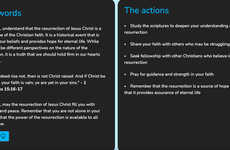
1,600 Year Old Codex Sinaiticus Bible Put Online
Andrew Robichaud — July 6, 2009 — Social Good
References: codex-sinaiticus.net
Now that a four-year project has concluded (probably not quite, but close), the world's oldest Bible, at 1,600 years old, has been put online for worldwide research.
The Bible was divided into many sections that had been accumulated across the world until a determined foursome began the project of reassembling the ancient script.
The British Library, The National Library of Russia, St. Catherine’s Monastery, and The Leipzig University Library all had a direct hand in putting the project together, eventually leading to the virtual Codex Sinaiticus Bible.
It is a religious relic that the world deserves to have a part of and thanks to a group of determined individuals (and MASS teams behind them), we now have the chance to look at a vital piece of history.
The Bible was divided into many sections that had been accumulated across the world until a determined foursome began the project of reassembling the ancient script.
The British Library, The National Library of Russia, St. Catherine’s Monastery, and The Leipzig University Library all had a direct hand in putting the project together, eventually leading to the virtual Codex Sinaiticus Bible.
It is a religious relic that the world deserves to have a part of and thanks to a group of determined individuals (and MASS teams behind them), we now have the chance to look at a vital piece of history.
Trend Themes
1. Virtual Access to Historical Artifacts - The online availability of the 1,600-year-old Codex Sinaiticus Bible highlights the trend of digitizing and making ancient artifacts accessible to a global audience.
2. Collaborative Heritage Preservation - The collaboration between multiple institutions to assemble the Codex Sinaiticus Bible points to the trend of collective efforts in preserving and sharing cultural and historical relics.
3. Digital Archiving for Research - The virtualization of the Codex Sinaiticus Bible demonstrates the trend of utilizing digital platforms for scholarly research and analysis of ancient texts.
Industry Implications
1. Museum and Cultural Institutions - Museums and cultural institutions can leverage digital technologies to expand their reach by offering virtual access to historical artifacts, such as ancient religious texts like the Codex Sinaiticus Bible.
2. Library and Academic Institutions - Libraries and academic institutions can explore collaborations and digital archiving initiatives to preserve and provide research access to valuable historical manuscripts and texts like the Codex Sinaiticus Bible.
3. Digital Humanities - The digitization of ancient religious texts like the Codex Sinaiticus Bible presents opportunities for researchers and scholars in the field of digital humanities to investigate and leverage new methodologies for analysis and interpretation.
1.9
Score
Popularity
Activity
Freshness























